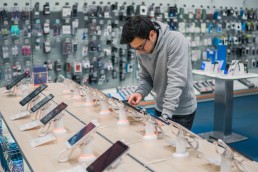Alexa vs Google Assistant - The Battle of the Voice Assistants
Voice Summit 2019 took place on July 22–26 in New Jersey. In the smart home space, voice is one of the key elements of a unified ecosystem, facilitating device control and interaction.
Within the wide portfolio of smart home hardware, smart speakers are usually the first entry into the space. In Europe, the smart speaker market is less than three years old, registering a growth of 526.7% from 2016 to 2017 and 90.2% from 2017 to 2018, with 16 million units shipped in 2018. The first question before buying one of these devices is which one — Amazon Alexa or Google Assistant?
Amazon Alexa – The Pioneer
Alexa and the first Amazon Echo were released in the US in November 2014 for Prime members only. It took almost two years for Amazon to release a smart speaker in Europe (September 2016), debuting with an English version in the UK and a German version for Germany and Austria. Since then, Amazon has also released local-language devices in France, Italy, and Spain.
Google Assistant
Though Google Voice Assistant was released in May 2016 through a mobile app, it was only at the end of that year that Google released its first smart speaker: the Google Home. In Europe, the first devices were launched in the UK in the second quarter of 2017 and in Germany and France in the following quarter.
Taking advantage of having Google Assistant in a range of devices, from smart TVs to Android mobile phones, Google was able to gain rapid traction; its smart speakers are now available in 10 European countries.
The Competition
Amazon and Google are putting a lot of effort into the race to be the smart home market leader. This applies to the full range of smart home devices, and not just smart speakers.
Both brands know that voice assistants are a good way of getting information on consumer behaviuor and purchasing trends. Research shows that when consumers make their first smart speaker choice, they become bonded to an ecosystem that will determine their preferences for further smart home purchases… so Google or Alexa?
With this in mind, Amazon and Google have been in a constant price and promotions war. Of course, as they try to strengthen their position and increase their penetration across Europe. Both offer a similar range of smart speakers. From the smaller (and best-selling) versions, to regular speakers and smart displays. These are the most recent addition to the vendors’ portfolios.
However, their strategies have been different. Amazon has been trying to increase its device capabilities and expand the use cases for its smart speakers. For example, Improving Alexa’s skills in each of the existing languages and promoting the ongoing development of new skills has also enhanced the end-user experience.
Google is much more focused on developing new languages and entering new countries, working on the basic commands and questions for smart speakers.
From 2016 to 2018, Alexa was the best voice assistant in Europe, making Amazon the leader of the smart speaker market. The market is currently driven by the first-entrant advantage: the first voice assistant that enters a new market automatically establishes a lead in that location.
As both tech giants move to new geographies, managing the supply chain and new launches can be challenging. Even Amazon, which had the first-entrant advantage in the UK and Germany, the two biggest markets in Western Europe, has had its share of problems. These included supply issues with Echo devices and Google’s expansion into new countries (enabling Google to gain the top spot in the market in 1Q19).
The Voice Assistant’s Market
The two leading suppliers also face competition from other players. Traditional technology players (i.e. Sony, LG Electronics, and Lenovo) and regular speaker makers (i.e. JBL, Sonos, and Bose) also launched devices. Though they have only a small share of the market, these players are more focused on sound quality. Also, they have partnered with either Amazon or Google (or both) to use their artificial intelligence capabilities.
Amazon and Google, of course, want to be available in as many devices as possible to maintain their leading positions. Even though they could try to get exclusivity from one of the third-party manufacturers, the first smart speakers enabling both Amazon and Google Assistant were already launched in 2Q19.
Being able to choose which voice assistant to use will be crucial, as this will be the hook to lock consumers into one voice assistant and one ecosystem from day one.
There are other voice assistants in the European market. For example, Apple’s Siri and the HomePod smart speaker; or Samsung’s Bixby, which is expected to arrive in Europe later this year. But the space is still heavily dominated by Alexa and Google Assistant.
Though they have different strategies, IDC still expects both of them to expand to new countries over the next few years, enabling new languages and more capabilities, and democratizing the interaction with electronic devices through voice. IDC expects the market to grow to 43 million units shipped in 2023 in Europe, with a CAGR of 21.93% from 2018 to 2023.
If you want to learn more about this topic or have any questions, please contact Antonio Arantes or head over to https://www.idc.com/eu and drop your details in the form on the top right.
Telco Retail Finds New Life as Heart of Smartphone Business
Most people around the world no longer buy a phone from a mobile operator, but this remains the retail outlet where all the big brands want to be — for good reason.
Data from the IDC Worldwide Quarterly Mobile Phone Tracker shows that since 2010 the proportion of smartphones sold by mobile operators worldwide has fallen by half, from more than 60% to little more than 30%.
Taken longer term and including feature phones, the number of phones sold through operators has fallen ever more precipitously — from a peak of a billion units in 2008 to 440 million in 2018.
The three charts here show, however, how telco retail is no longer becoming less important in the phone retailing business. (IDC uses “telco” for the operator channel, and that is the term mainly used here. Telco can also include other types of telecommunications operator, but the difference is rarely significant. Value figures refer to retail prices before sales tax.)


The first chart shows the unit decline, but the second chart shows why telco has retained its importance — There is no longer any significant drop in value terms in telco phone sales value measured at retail prices before tax. Instead, the telco channel is not losing its sway and has been retaining share in recent quarters, with total sales of around $200 billion a year.

The third chart shows the reason for this — while the mobile industry as a whole is seeing average sales prices rise, the average sales price through telco outlets is increasing more rapidly than in other retail. This is true of most global regions, according to IDC data.
Developed-Market Bias
North America accounts for nearly a quarter of global telco phone retail units and nearly a third of the value. Europe as a whole accounts for close to another 20% of global volumes and slightly more by value.
Telco distribution in Asia is dominated by China, whose telco retail accounts for more units than Europe. Together the US, Europe, and China account for nearly two-thirds of all global telco sales of smartphones.
In contrast, across a great swathe of emerging markets, operator retail is not very important at all. The countries where operator retail accounts for less than 10% of smartphone sales make up half of the world’s population. Their telco retail total, at 13.9 million smartphones in 2018, is not much more than the number sold by operators in the UK that year.
The key reason for this “telco gap” is that when mobile operators got going three decades or more ago, they did so first in richer countries. With the initial cost of phones very high, it made sense as a business to effectively rent them to users while at the same time charging for their use — hence the “postpaid” model.
When mobile got established, rather later, in emerging markets, a lot of the initial ventures were small-scale with limited capital. Many of these countries were politically unstable and had currency controls on exporting profits or import arrangements where a legitimate business could not compete with grey market operators. Outlays were kept to a minimum, which meant keeping out of the handset business.
This does not quite add up to a close correlation between high average sales price countries against the proportion of telco distribution. There are countries with high GDP per capita and very little telco distribution, such as the nation states of the Persian Gulf. And there are middling developed countries heavily controlled by telco — Latin America is roughly half telco distribution. But in general, telco has a strong developed-market bias.
Privilege and Entitlement
Telco shops are often pretty spiffy and have cool décor and presentation. Nevertheless, aesthetics aside, telco distribution is a bit of an old boys’ club. Long-established relationships with vendors still hold sway. It was no coincidence that the first big set of mobile phone vendors came from telco infrastructure companies, which were already de facto in the club because they already had business relationships with the operators.
The telco club has other common features to other old boys’ clubs: it has privilege, in its access to and relationship to a customer base. Its outlets often have a display room for a limited number of brands (read members’ chairs in the reading room). Fading vendors still tend to be in there (read older members left in peace in their chairs to snooze undisturbed).
As a phone vendor, you might not like the stuffiness of the club or the sense of entitlement, but once you are in, you are in. You can offload lots of inventory to just a small group of buyers, and as there are rarely more than four mobile operators in a country, each is pretty much guaranteed to have a substantial sell-through.
Vendors that try to do it on their own find the going tough. The most successful smartphone brands outside telco distribution — notably China’s Xiaomi, Vivo and OPPO — all started out as scrappy players determined to show you could make it without being members of the phone-making establishment. None of them started out making network telecoms gear either.
In countries with no or a weak old boys’ club in operator retail, the outsiders have done well. They dominate phone sales in India.
Time to Join the Club
But in countries where the club is still going strong — in Europe, for instance — they are having trouble finding their way outside the club and they may have to change tack. That’s not so easy, as the club is not that open to new members. Are they one of us, the membership committee thinks, and will they fit in? Do we have any space with all those old members still snoozing there?
Old boys’ clubs are all about networks, and so are telcos — just a different type of network. Just as clubs want members who will fit in, their sort of people, mobile operators want phones that will fit in, that work well on their networks and use their spectrum seamlessly and efficiently. This has been one of the factors that has spurred some operators to become more involved in phone retail. In Russia, in Bangladesh and in a couple of countries in Latin America, operator share has bucked the global trend and grown in recent quarters.
The launch of 5G is another reason for operators to want a prominent role in phone retail. 5G is not going to happen in many places without some clever bundling of traffic and devices, and that means operator involvement.
Operator stores will remain the main route to selling top-end phones, as they offer postpaid packages that still get consumers swapping out their old models for new ones after a relatively short time. There is a lot of life in the old boys’ club yet, as the smartphone upstarts who chose other routes might reflect. In so many fields an upstart goes from being an outsider to, later in life, joining the establishment.
If you want to learn more about this topic or have any questions, please contact Simon Baker or head over to https://www.idc.com/eu and drop your details in the form on the top right.
Microsoft Partners with OpenAI, Sets Sights on Google
Microsoft has announced it will invest $1 billion in San Francisco–based research group OpenAI. OpenAI said the investment and collaboration with Microsoft would help the two organizations pursue Artificial General Intelligence (AGI), development of an Azure AI computing platform, and an agreement to port OpenAI's services to run on Azure.
Opportunities for WiFi in Public Spaces
Demand for funding through the European Commission’s WiFi4EU program demonstrates that there is still considerable interest for WiFi in public spaces by municipalities.
Yet, cities have struggled to develop business use cases to support investment past proof-of-concept stages. Improvements in the underlying technology and the corresponding ability to connect a growing number of devices are helping to broaden the range of potential business models and use cases, so is the time right for cities to once again invest in WiFi in public spaces?
Bridging the Funding and Technology Gap
Cities’ interest in WiFi is nothing new, and early examples can be found dating back more than 20 years when the first cities started to experiment with providing access to public services across narrowly defined geographic areas. However, many of the original schemes failed or were scaled back significantly due to a series of challenges ranging from cost to poor quality.
The issue of cost is a perennial one for cities. While cities have big budgets, discretionary items such as public WiFi programs have in recent years been scaled back in response to the tight fiscal environment, limiting deployments to public buildings. Adding to the complexity is the fragmented nature of budgets, making it difficult to secure long-term support.
Also, if and when the solution is launched and set up, municipalities face the problem with its support because very often there is a lack of internal IT skills and outsourcing the support to a third party puts additional pressure on the budgets.
Recently though there have been moves to inject new investment through schemes such as the European Commission’s WiFi4EU project. While the scheme provides investment to kick-start municipalities’ plans, with each award worth roughly €15,000, the challenge of securing longer-term funding is still a complex issue.
Developing support requires cities to develop new business models that will see them use WiFi to address more complex issues. Combining WiFi deployments as part of wider programs makes it easier to justify the cost and opens up avenues to engage with different budget holders.
To date the technical limitations of WiFi have meant that cities have struggled to use it in support of more than a handful of use cases, the bulk of which revolve around access to online services for citizens. Development of the next evolution of WiFi standards, WiFi 6, will provide improvements in speeds and latency, with support for higher density of connected devices.
It is also likely to have lower costs to deploy, maintain, and manage — making it an attractive solution for cities. The range of use cases that can be applied to WiFi in public spaces is expanding as cities start to adopt Internet of Things (IoT) and autonomous devices services.
Partnering for Success
Utilizing connectivity solutions such as WiFi to provide access to digital services is a core part of many municipalities’ journey to becoming a smart city. As the cost of providing the infrastructure continues to decrease, vendors are developing additional services that wrap around the underlying infrastructure, such as improved management tools, more detailed analytics on use and devices, and the use of automation to move from reactive to proactive operation and fault management of services.
For municipalities this means they will need to work toward understanding how access technologies are evolving and what this means in terms of future use cases that can help to financially support the rollout of WiFi across public spaces. For vendors there will no doubt be opportunities to help municipalities by identifying other parties that are also deploying access in public spaces and helping to bridge gaps in coverage between other connectivity services.
However, this will require the development of commercial arrangements to suit all parties. Which brings us back round to funding.
Choosing the Right Solution
Despite the use case that public WiFi is used for, municipalities should wisely choose the technical solution. Very often municipalities don’t have a clear picture of what the whole smart ecosystem will look like in several years.
Thus, the choice of interoperable solution is vital. Many vendors and partners create platforms that enable them to seamlessly integrate any new use cases into the larger ecosystem and avoid rip and replace practice and hence avoid budget overspend. Vendors such as Ruckus (Commscope), Aruba/HPE, Cisco, Nokia, and Huawei are all proponents of gradual development.
To provide municipalities with the right solution, vendors are working closely with a myriad of partners from service providers to EU regulatory bodies. Vendors are constantly working on improving not only the functionality of their products but also the look, as in European cities that are closely watched by UNESCO and other heritage institutions the appearance of any technology and its ability to blend into the surroundings is imperative.








